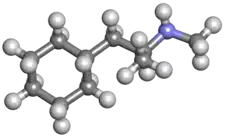Propylhexedrine
 | |
 | |
| Names | |
|---|---|
| Trade names | Benzedrex, Obesin, others |
| Other names | Hexahydro-desoxyephedrine; Hexahydro-methamphetamine; Hydromethamphetamine; Dimethylcyclo-hexaneethanamine; Cycohexyliso-propylmethylamine; Propylhexedrinum |
IUPAC name
| |
| Clinical data | |
| Main uses | Stuffy nose[1] |
| Side effects | Burning, nasal discharge[1] |
| WHO AWaRe | UnlinkedWikibase error: ⧼unlinkedwikibase-error-statements-entity-not-set⧽ |
| Pregnancy category |
|
| Routes of use | Medical: Intranasal, by mouth Recreational: By mouth, by injection |
| Onset of action | Within 5 min[1] |
| Duration of action | Up to 2 hrs[1] |
| External links | |
| AHFS/Drugs.com | Monograph |
| Legal | |
| Legal status |
|
| Pharmacokinetics | |
| Elimination half-life | 4 ± 1.5 hours |
| Chemical and physical data | |
| Formula | C10H21N |
| Molar mass | 155.285 g·mol−1 |
| 3D model (JSmol) | |
| Chirality | Racemic mixture |
SMILES
| |
InChI
| |
Propylhexedrine, sold under the brand names Benzedrex among others, is a medication used for a stuffy nose.[1] It is used in the nose.[1] Benefits begin within 5 minutes and may last for up to 2 hours.[1] Use is not recommended for more than three days.[2]
Common side effects include burning and nasal discharge.[1] Other concerns include headache, high blood pressure, and psychosis.[1] Safety in pregnancy is unclear.[1] It works similar to amphetamines by causing small arteries to constrict.[1]
Propylhexedrine came into commercial use in 1949.[3] It is available over the counter.[1] In the United States a delivery device costs about 13 USD as of 2021.[4] It is not a controlled substance in the United States.[1] It has also been used for weight loss and misused by people trying to get high.[5][6][7]
Medical use
Propylhexedrine is used to treat acute nasal congestion related to common cold,[8] allergies and hay fever.
Historically, it has also been used for weight loss, typically at doses from 5 to 30 milligrams.[9][7]
Dosage
For nasal congestion, the dosage is listed as four inhalations (two inhalations per nostril) every two hours for adults and children 6–12 years of age. Each inhalation delivers 0.4 to 0.5 milligram (400 to 500 μg) in 800 millilitres of air.[8]
Contraindications
Propylhexedrine should not be used if an MAOI has been used in the past 14 days, or is being currently used, as this can lead to a hypertensive crisis. People with cardiovascular disease should not use propylhexedrine.[10]
Additionally, drugs such as stimulants and sympathomimetics should not be taken with propylhexedrine, as this can lead to potentially dangerous spikes in blood pressure and irregular heart rhythms.[11]
There is one case of death where a combination of propylhexedrine, acetaminophen, morphine, promethazine, and kratom was detected. However the study indicates that propylhexedrine was most likely the principal cause of death.[12]
Pharmacology
Propylhexedrine is a TAAR1 agonist, like amphetamine.[13] Consequently, it reverses the transporters for dopamine, norepinephrine, and serotonin, leading to a release of monoamines from presynaptic vesicles into the synaptic cleft.[13] The increased level of monoamines within the synapse results in increased activity at their respective receptors. Additionally, propylhexedrine appears to inhibit VMAT2, leading to a further increase in the aforementioned monoamines.[13] The pharmacological actions of propylhexedrine are similar to that of structurally similar stimulant phenethylamines, such as amphetamine.[13]
Metabolism
Propylhexedrine undergoes metabolism to form various metabolites including norpropylhexedrine, cyclohexylacetoxime, cis- and trans-4-hydroxypropylhexedrine.[14]
Chemistry
Freebase propylhexedrine is a volatile, oily liquid at room temperature. The slow evaporation of freebase propylhexedrine allows it to be administered via inhalation.[15] As an amine, it can easily be protonated to form various salts, such as propylhexedrine hydrochloride, propylhexedrine citrate, or propylhexedrine acetate, depending on the acid used. These salts are stable, clear to off-white crystalline substances that readily dissolve in water.[16]
Propylhexedrine is structurally similar to phenylethylamines, with the only structural difference being the substitution of an alicyclic cyclohexyl group for the aromatic phenyl group of phenethylamine. Propylhexedrine is not an amphetamine, nor even a phenethylamine, but instead can be referred to as a cycloalkyl amine, or more specifically a cyclohexylethylamine being the N,a-dimethyl derivative of 2-cyclohexylethylamine.
Propylhexedrine is a chiral compound (the α-carbon is chiral), and the active ingredient contained in Benzedrex inhalers is racemic (RS)-propylhexedrine as the free base. (S)-Propylhexedrine, also known as levopropylhexedrine, is believed to be the more biologically active isomer of the two.[17] (S)-Propylhexedrine can be synthesized from dextromethamphetamine.[18]
Synthesis
Propylhexedrine can be synthesized starting with cyclohexylacetone in a similar fashion to the phenylacetone synthesis of methamphetamine.[19]
However, more commonly propylhexedrine is prepared by reacting methamphetamine with Adams' catalyst, reducing methamphetamine's aromatic ring to a cyclohexyl moiety.

History
Benzedrex was first manufactured by Smith, Kline and French after the Benzedrine inhaler, which contained racemic amphetamine, became unavailable following the placement of amphetamines on the US Schedule II status (highest abuse potential, yet with accepted medicinal uses). Benzedrex is currently manufactured by B.F. Ascher & Co. Inc. Pharmaceuticals.[8]
Propylhexedrine has also been useed in Europe as an appetite suppressant under the trade name Obesin[21] and in the anticonvulsant preparation barbexaclone its S-isomer (levopropylhexedrine or L-propylhexedrine) is bonded with phenobarbital for the purpose of offsetting the barbiturate-induced sedation.[21] Levopropylhexedrine is also used as an anorectic under the brand name Eventin.[22]
Society and culture
Recreational use
Propylhexedrine is used recreationally in a manner similar to amphetamine, methamphetamine, and dextroamphetamine. Users report a high similar to other amphetamines, but often much more euphoric. Compared to both amphetamine and methamphetamine, propylhexedrine has a much shorter duration of action (which is generally considered undesirable by recreational users). In addition, propylhexedrine products are manufactured using delivery devices (such as sub-recreational-dosage inhalers) that are difficult (or nearly impossible) to consume effectively (at recreational doses) via non-oral routes of administration, further limiting its ability to match or replace other amphetamine-related stimulants for recreational use. The negative physical side effects of propylhexedrine at recreational doses are often notably worse than non-IV methamphetamine, amphetamine, and other commonly abused stimulants, making it sub-optimal for long term recreational use.
Long-term health problems may develop from daily use. Compared to dextroamphetamine, it is a heavier strain on the cardiovascular system, and the risk of heart damage increases when used daily. Unlike amphetamine, propylhexedrine's serotonin-releasing properties have the potential to cause long term negative side effects similar to MDMA abuse, though the degree in which decreased serotonergic neurotransmission occurs as a result of recreational propylhexedrine usage is largely unclear in the relevant literature.
Effects
Propylhexedrine has sympathomimetic, adrenergic, vasoconstrictive and psychostimulant effects when taken above the medical dosage. Effects include increased sweating, talkativeness, mydriasis, emotional lability, anorexia, tachycardia, palpitations, dry mouth, bruxism, anxiety, euphoria or dysphoria, increased aggressiveness, paranoia, headache, dizziness, psychosis, slurred or impaired speech, rarely convulsions and serious heart problems.[23] Propylhexedrine can also cause swelling, dryness and irritation of mucous membranes.[24]
Injection risks
While propylhexedrine is limited in a number of administration routes, attempts to extract the drug from the nasal inhaler and then inject it have been reported. Recreational use by intravenous injection (IV) is dangerous and could result in serious bodily harm or death. IV use of propylhexedrine is known to cause mild side-effects such as transient diplopia as well as some serious (and potentially fatal) effects such as brainstem dysfunction, and deaths have been recorded in the medical literature. Typically, recorded cases of IV use are prepared by placing propylhexedrine freebase in a solution with hydrochloric acid to form propylhexedrine HCl, the solution is then heated to evaporate the solvent and the resulting crystals are dissolved in water for injection.[25][26][23]
References
- 1 2 3 4 5 6 7 8 9 10 11 12 13 "Propylhexedrine Monograph for Professionals". Drugs.com. Archived from the original on 27 January 2021. Retrieved 29 October 2021.
- ↑ "DailyMed - BENZEDREX 09-19-2014- propylhexedrine inhalant". dailymed.nlm.nih.gov. Archived from the original on 26 March 2021. Retrieved 29 October 2021.
- ↑ MD, Steven B. Karch; Drummer, Olaf (11 November 2015). Karch's Pathology of Drug Abuse. CRC Press. p. 1734. ISBN 978-1-4987-6650-0. Archived from the original on 30 October 2021. Retrieved 29 October 2021.
- ↑ "Benzedrex Prices, Coupons & Patient Assistance Programs". Drugs.com. Retrieved 29 October 2021.
- ↑ Dart, Richard C. (2004). Medical Toxicology. Lippincott Williams & Wilkins. p. 1073. ISBN 978-0-7817-2845-4. Archived from the original on 30 October 2021. Retrieved 29 October 2021.
- ↑ Docherty JR (June 2008). "Pharmacology of stimulants prohibited by the World Anti-Doping Agency (WADA)". British Journal of Pharmacology. 154 (3): 606–22. doi:10.1038/bjp.2008.124. PMC 2439527. PMID 18500382.
- 1 2 Ries, Richard K.; Miller, Shannon C.; Fiellin, David A. (2009). Principles of Addiction Medicine. Lippincott Williams & Wilkins. p. 138. ISBN 978-0-7817-7477-2. Archived from the original on 30 October 2021. Retrieved 29 October 2021.
- 1 2 3 "Benzedrex Inhaler Nasal Decongestant Inhaler". B.F. Ascher & Company, Inc. Archived from the original on 10 August 2013. Retrieved 27 March 2013.
- ↑ "Obesin Dosage, Interactions". Archived from the original on 24 October 2017. Retrieved 23 October 2017.
- ↑ "Propylhexedrine Contraindications". Medscape. Archived from the original on 25 March 2021. Retrieved 9 October 2021.
- ↑ "Safety of mixing stimulants with medications". NIDA. Archived from the original on 1 April 2019. Retrieved 9 October 2021.
- ↑ Holler JM, Vorce SP, McDonough-Bender PC, Magluilo J, Solomon CJ, Levine B (January 2011). "A drug toxicity death involving propylhexedrine and mitragynine". Journal of Analytical Toxicology. 35 (1): 54–9. doi:10.1093/anatox/35.1.54. PMID 21219704.
- 1 2 3 4 "Propylhexedrine". DrugBank. Archived from the original on 27 June 2020. Retrieved 9 October 2021.
- ↑ Midha KK, Beckett AH, Saunders A (October 1974). "Identification of the major metabolites of propylhexedrine in vivo (in man) and in vitro (in guinea pig and rabbit)". Xenobiotica; the Fate of Foreign Compounds in Biological Systems. 4 (10): 627–35. doi:10.1080/00498257409169765. PMID 4428789.
- ↑ US granted 4095596, Grayson M, "Nasal Inhaler", issued 20 June 1978, assigned to Smithkline Corp.
- ↑ Mancusi-Ungaro HR, Decker WJ, Forshan VR, Blackwell SJ, Lewis SR (1983). "Tissue injuries associated with parenteral propylhexedrine abuse". Journal of Toxicology. Clinical Toxicology. 21 (3): 359–72. doi:10.1097/00005373-198307000-00114. PMID 6144800.
- ↑ Lands AM, Nash VL (April 1947). "The pharmacologic activity of N-methyl-beta-cyclohexyl-isopropylamine hydrochloride". The Journal of Pharmacology and Experimental Therapeutics. 89 (4): 382–5. PMID 20295519. Archived from the original on 21 October 2021. Retrieved 9 October 2021.
- ↑ Wilson CO, Gisvold O, Doerge RF (1971). Textbook of organic medicinal and pharmaceutical chemistry. Lippincott. p. 491. ISBN 9780397520558.
- ↑ Lednicer D, Mitscher LA (1977). Organic Chemistry of Drug Synthesis. Vol. 1. New York, NY: Wiley. p. 37. ISBN 978-0-471-52141-9.
- ↑ Zenitz BL, Macks EB, Moore ML (May 1947). "Preparation of some primary and secondary beta-cyclohexylalkylamines". Journal of the American Chemical Society. 69 (5): 1117–21. doi:10.1021/ja01197a039. PMID 20240502.
- 1 2 Wesson DR (June 1986). "Propylhexdrine". Drug and Alcohol Dependence. 17 (2–3): 273–8. doi:10.1016/0376-8716(86)90013-X. PMID 2874970.
- ↑ "Eventin". Drugs.com. Archived from the original on 14 July 2014. Retrieved 27 March 2013.
- 1 2 Fornazzari L, Carlen PL, Kapur BM (November 1986). "Intravenous abuse of propylhexedrine (Benzedrex) and the risk of brainstem dysfunction in young adults". The Canadian Journal of Neurological Sciences. 13 (4): 337–9. doi:10.1017/S0317167100036696. PMID 2877725.
- ↑ "Safety Data Sheet – Cayman Chemical" (PDF). Archived (PDF) from the original on 9 November 2020. Retrieved 9 October 2021.
- ↑ "Proposed Rules". Federal Register. 50 (10): 2226–2227.
- ↑ Prince v. Ascher, 90 P.3d 1020 (2004).
External links
| Identifiers: |
|---|